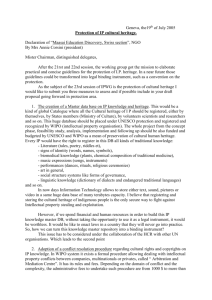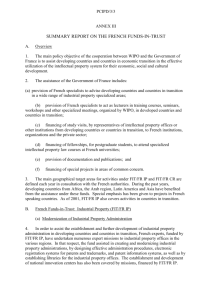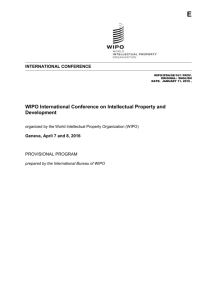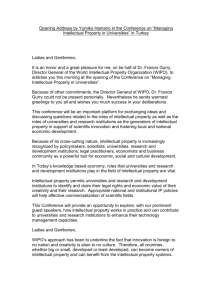Copyright in Europe
advertisement
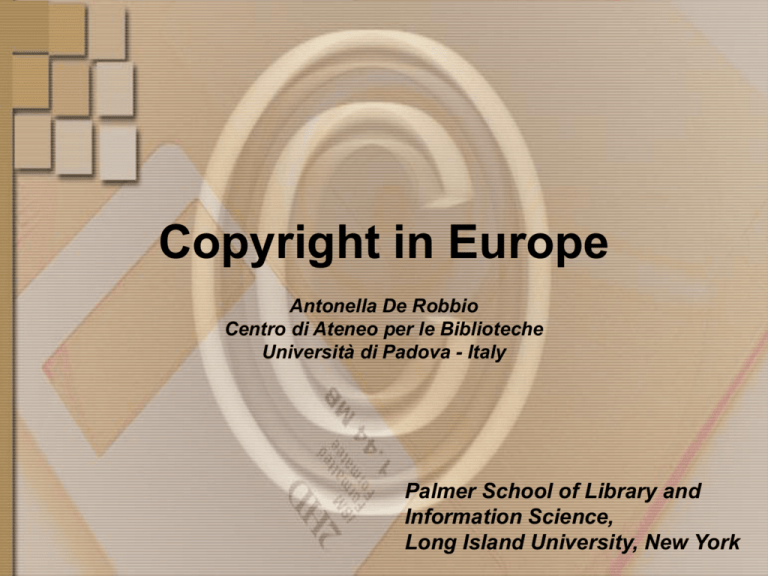
Copyright in Europe Antonella De Robbio Centro di Ateneo per le Biblioteche Università di Padova - Italy Palmer School of Library and Information Science, Long Island University, New York Principles of Intellectual property • • • • Copyright does not protect ideas, but only their expression in a particular creation. This requirement enables to reconcile the interests of both creators and society, by preserving the free movement of ideas. The idea to create a guide explaining the main principles of copyright can not be protected by copyright. The expression of this idea into the particular form of the guide can be protected by copyright. Copyright protects the form given to an idea, it is the envelope not the essence. It is a formal asset, a social agreement based on consensus. Closed ideas = no innovation Time = protection (70 years) Space: originallity concept Form idea Concetto spazio/tempo espresso da Jack Balkin The two sides of IP • Intellectual Property protects the different types of intellectual creations. • It is usually divided into two parts: – industrial property (Paris Convention,1883) – literary and artistic property (Berna Convention, 1886) • Industrial property comprises mainly of trademark law, designs and models and patent law. Patent law protects new inventions, whereas trademark law protects signs used in commerce to distinguish the origin of goods or services. Designs and models protects the new design of an utilitarian object. • Literary and artistic property comprises mainly of copyright. Not only copyright • • • • • • • There are different normative systems which regulate IP Copyright is only one and is different for each country: US, UK, Canada, Japan etc. US Copyright is based on Common Law and Fair Use European system is based on the right of author which originates from Roman Right (paternity right) Ex socialist Countries are changing their laws Some Arabic countries are regulated byTeological systems China adopted International treatises but its traditional culture is based on art of the copy as the transmission channel of knowledge Africa bases its culture on oral communication, so copyright is perceived as something colonial Difference between formal systems and legal systems • We need to focus on the context • The system reflects traditions and cultures of each country (economic, social and historical issues) • We cannot use copyright terms solely to define other rights: in EU we use copyright terms to define economic rights • The different systems are harmonized by WIPO activity and regulated by international treatises (TRIPs) and by the Universal Convention of Berna Right over the Information versus Right to the information • In Europe the droit d’auteur system is oriented to protect the author (personal right) • In the US copyright system the moral rights are lighter: copy-right = user right to make a copy of the work Balancing the two fundamental rights • Copyright with author rights and connected rights • Right to access to information • Libraries have an important role in this balancing act • In the EU there are some problems about the Directive on lending: the law requires payment for such right! Harmonization levels: the three boxes international context: treatises, agreements and conventions in order to harmonize the difference between national systems. WIPO activities. EU context: there are seven EU Directive focused on copyright matters. last level: the national context adoption of EU Directives and International dispositions (sometimes in conflict) in order to create a new legislative enviroment and new legal tools modifications coming from national and internal front (often crazy ideas about payment of rights to some commercial lobby). WIPO World Intellectual Property Organization A 1967 Convention sought to encourage creative activity by establishing WIPO to promote the protection of intellectual property. The mission was expanded in 1974, when WIPO became part of the United Nations, under an agreement that asked WIPO to take "appropriate action to promote creative intellectual activity," and facilitate the transfer of technology to developing countries, "in order to accelerate economic, social and cultural development." Berne Convention for the Protection of Literary and Artistic Works art. 9 Berne Convetion defines reproduction right (analogic and digital environment) 1996 WIPO Copyright Treaty – WIPO Performances and Phonograms Treaty (recent) • As an intergovernmental organization, however, WIPO embraced a culture of creating and expanding monopoly privileges, often without regard to consequences. • The continuous expansion of these privileges and their enforcement mechanisms has led to grave social and economic costs, and has hampered and threatened other important systems of creativity and innovation Geneva Declaration on the Future of the WIPO • WIPO must change • WIPO needs to enable its members to understand the real economic and social consequences of excessive intellectual property protections, and the importance of striking a balance between the public domain and competition on the one hand, and the realm of property rights on the other. • WIPO must also express a more balanced view of the relative benefits of harmonization and diversity, and seek to impose global conformity only when it truly benefits all of humanity. European context • "Green Paper on Copyright and the Challenge of technology“ • the White Papers in answer to Green paper • EU actions are based on three concepts: – Information Society – Learning Society – Knowledge Society The seven European Directives 1. 2. 3. 4. 5. Council Directive 91/250/EEC of 14 May 1991 on the legal protection of computer programs Council Directive 92/100/EEC of 19 November 1992 on rental right and lending right and on certain rights related to copyright in the field of intellectual property Council Directive 93/83/EEC of 27 September 1993 on the coordination of certain rules concerning copyright and rights related to copyright applicable to satellite broadcasting and cable retransmission (communication and diffusion rights) Council Directive 93/98/EEC of 29 October 1993 harmonizing the term of protection of copyright and certain related rights Directive 96/9/EC of the European Parliament and of the Council of 11 March 1996 on the legal protection of databases The seven European Directives 6. Directive 2001/29/EC of the European Parliament and of the Council of 22 May 2001 on the harmonisation of certain aspects of copyright and related rights in the information society 7. Directive 2001/84/EC of the European Parliament and of the Council of 27 September 2001 on the resale right for the benefit of the author of an original work of art The Sixth Directive • Directive 2001/29/EC of the European Parliament and of the Council of 22 May 2001 on the harmonization of certain aspects of copyright and related rights in the information society • Harmonization between physical and digital work • Not moral rights • Only three economic rights: Reproduction rights Distribution right Right to communicate to public • It introduces the fair payment but without fair use (that’s not good for the European regime which is based on exceptions) • It foresees about 20 exceptions, but each State member can adopt them or not (that’s wrong!) • Ephemeral copy is foreseen Copyright protection • No formality : – to enjoy copyright protection, no formality (registration...) is required. Copyright protection is granted from the sole fact of the creation of the work. • Usefulness of mentions to enable author identification enabling (like the "© Copyright Name of author" mention) – the COPYRIGHT mention is absolutely not mandatory to enjoy copyright protection. However, it is very useful in case of dispute since it can constitute presumption of rights ownership. • Usefulness of the registration of copyrighted works : • in the same way, the registration of works (ISBN, for instance), which is not mandatory at all, can be very helpful to prove a disputed creation. Unprotected Works • Some types of creations are not protected by copyright. • Some creations do not meet copyright protection requirements : – – – – – ideas ; information as itself ; mathematical theories ; algorithms ; works which are not original ; • Other creations can no longer enjoy copyright protection since their protection term has expired (in principle, 70 years after the death of the author). • Finally, some creations are outside the scope of copyright. This is often the case for political speeches or court decisions. The dualism of droit d’auteur • Moral right • Economic rights • Italy, France, Germany have similar legislation • The UK has a law based on copyright, slightly different from US (influence of EU context) (fair dealing) • ex Russian countries are adopting EU laws The moral rights • paternity: the author has a paternity right which enables him to have his name on the work. • integrity: which enables the author to refuse any modification to the work (or its context) or any re-use of it. • moral rights aim at protecting creator's personality which is expressed through the work. • Moral rights do not have a harmonized term: in some countries (France), moral rights are perpetual, whereas in others, they expire at the same time as economic rights. • Moral rights can not be transferred. • The author always remains the owner of the moral rights. Economic rights Exclusive rights • • • • • • • • • • • publication reproduction transcription public representation diffusion (distance means) right to communicate to the public (TV, broadcasting) distribution (market) translation publication inside a collective work reworking lending Economic rights • Economic rights aim to enable the author to take some revenue from the exploitation of his work. • The author has the exclusive right to reproduce and communicate his work to the public. • Reproduction right allows the author to reproduce, in whole or in part, his work, in whatever medium and in any form. Any reproduction of a copyrighted work requires the prior consent of its author. • The Right to communicate the work to the public covers any direct communication of the work to the public, without any material embodiment (concert, television, webcasting). The prior consent of the author is required. • Economic rights expire in principle 70 years after the author’s death. • Economic rights may be transferred. Limitations and exceptions • • • • Different exceptions exist for each different right Following the recent laws (internal and European) there is no further free usage In respect of research (and other activities contributing to social, cultural or individual benefits), not every form of use requires the authorization of the right holder. Legislation in all Member States provides for such statutory limitations. As a general overview, limitations in the Member States' copyright law which are relevant for science and research activities concern mainly: • • • • • • • scientific use library and archive use educational use / teaching private use users with handicap quotation Limitations don’t require authorization but payment of a forfait quote is necessary Database copyright protection • Dual approach: – original creations: moral rights – author’s right – sui generis right for non-creative works • Copyright in the database selection or arrangement exists for those databases which constitute their authors' own intellectual creation. • EU law is very different from US copyright (lack of harmonization between them) • The general term of protection is fifteen years from the date the database publication or manufacture. • Sui generis right is a connected right IMMATERIAL GOODS INTELLECTUAL WORKS WORK SUPPORT Digital library and copyright • The electronic copyright is the main issue in building digital libraries • Three important rights are involved: – reproduction right – right of communication to public (diffusion) – distribution right • In Europe – diritto d’autore – two permissions are needed from: – publisher (in case of right cession) – author (one or more) about moral rights In Italy • Legge 22 aprile 1941 n. 633, "Protezione del diritto d'autore e di altri diritti connessi al suo esercizio” recently amended by – Legge 18 agosto 2000 n. 248, "Nuove norme di tutela del diritto di autore” – The Sixth Directive • Civil Code: art. 2575-2583 • Berne Convention Italian activities • Copyright on national front – – – – SIAE and Publishers association negotiation VAT matters on e-journals and db Adoption of Creative Commons licences Survey of Italian Publishing policies (Italian Sherpa) • Copyright on EU front – Copyright Policies and Agreements: implementing the Zwolle Principles – University Copyright Policies (previously on national CRUI front) Control of the contents and IP The three layers or places cited by Larry Lessig: Physical, logical and about content HydePark Corner • Physical: the park • Logical: individual language • content: speeches to the people Network • Physical: hardware level (machine) • Logical: Protocol, use, ... • Content: free circulation of contents on the web My page on copyright http://www.math.unipd.it/~derobbio/dd/copyr00.htm
![Invitation [word format]](http://s3.studylib.net/store/data/007096478_1-54334bf5ab877bf1ebd233e686a3f8bb-300x300.png)
